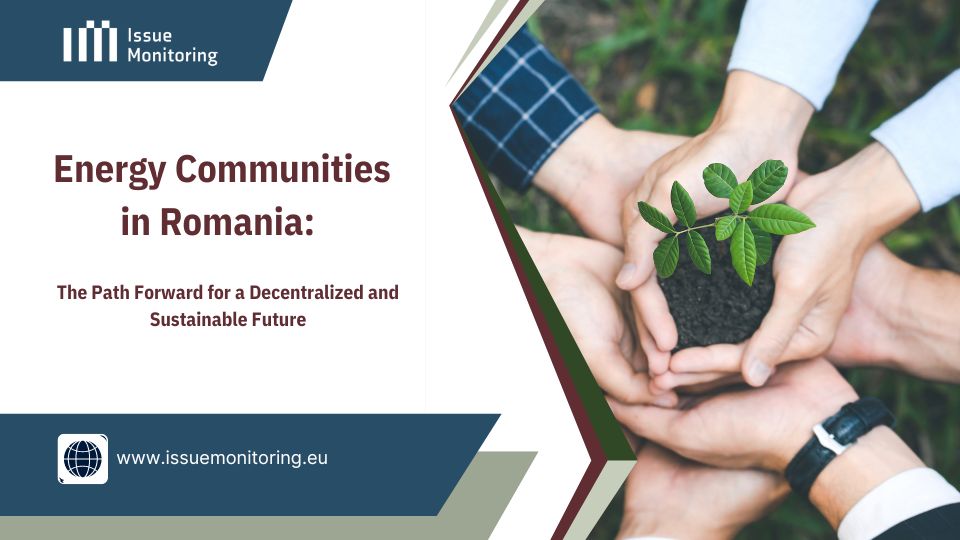
Article written by Eusebiu Valentin Stamate, Senior Public Policy Analyst @Issue Monitoring
As Romania faces increasing challenges related to energy security, climate change and the need for sustainable development, it is important to explore innovative solutions that empower local communities. Energy communities offer a way to decentralize energy production, engage local stakeholders, and promote the use of renewable resources.
By examining the current state of energy communities, this analysis seeks to highlight both the challenges and opportunities that can help shape future policies and actions. In a time of rapid technological advancements and shifting energy needs, it is essential to build a framework that allows all stakeholders, including the government, private sector and local communities, to participate in Romania’s energy transition. These decentralized energy systems, formed by local stakeholders such as residents, businesses and authorities, represent a significant shift towards enhancing energy security, sustainability, and community empowerment.
Current State of Energy Communities in Romania
Despite a few pilot projects and initiatives, Romania’s energy community development remains in its early stages. The existing policy framework is fragmented, lacking comprehensive legislation that addresses the specific needs of energy communities. Key challenges include:
- Absence of a clear and cohesive legislative framework
- Limited financial incentives and support mechanisms
- Low awareness and participation from local communities
- Technological barriers and inadequate infrastructure
The Existing Legal Framework: Room for Improvement
Romania currently has a legal definition for energy communities, introduced through GEO nr. 143/2021, that outlines their structure, roles, and responsibilities. However, many stakeholders find this definition lacking in clarity and flexibility, which limits its ability to encourage widespread adoption. It does not fully address the dynamic nature of energy communities, which vary widely in their structure and operation.
To make the legal framework more effective, it should provide:
- Flexibility: Energy communities come in different forms, from local cooperatives to public-private partnerships. The legal framework should accommodate this diversity.
- Clear Incentives: The current legal definition lacks sufficient incentives for communities to organize and operate energy projects. The framework can include tax reliefs and simplified regulatory processes to encourage participation.
- Streamlined Procedures: Administrative burdens often deter communities from setting up renewable energy projects. Simplifying approval and operational processes would help address these barriers.
Impact on Private Energy Suppliers: Challenges and Opportunities
While the development of energy communities brings competition to the energy market, it also presents numerous opportunities for private energy suppliers.
Challenges:
- Increased Competition: Energy communities produce energy locally, reducing dependence on traditional suppliers. As communities become more self-sufficient, the demand for energy from private suppliers may decrease, potentially leading to lower revenues.
- Reduced Market Share: As more communities generate their own energy, private suppliers might see a reduction in their customer base, particularly in areas where local energy production becomes widespread.
Opportunities:
- Collaborations and Partnerships: Instead of viewing energy communities as competitors, private suppliers could see them as partners. By offering services like energy storage solutions, maintenance, or consultancy, private suppliers can support communities in their energy production efforts and still maintain a role in the energy value chain.
- Balancing Services: As energy communities often rely on fluctuating renewable sources like solar and wind, private suppliers can offer balancing services to ensure stable energy supply during periods of low production. This collaboration would support both parties in creating a resilient energy system.
- Energy Storage Solutions: Suppliers can invest in energy storage technologies, providing communities with solutions to store excess energy for later use. This could become a profitable niche for energy suppliers looking to adapt to the changing landscape.
- Diversification of Offerings: Some suppliers may integrate renewable energy projects from communities into their energy mix or create hybrid offerings combining local production with traditional energy sources. This approach can smooth the transition and offer consumers more flexibility in their energy choices.
In summary, the rise of energy communities presents both challenges and opportunities for private energy suppliers. Those that adapt and embrace innovation can find ways to collaborate and thrive within this evolving market.
Learning from Other European Countries
Romania is not alone in facing challenges in developing energy communities. Several EU countries have successfully implemented frameworks that could serve as inspiration for Romanian policymakers. For example:
- Germany has become a leader in community wind farms, with local farmers and residents collectively owning renewable energy projects. Their cooperative model could be adapted to Romania’s context, encouraging local investment and long-term engagement.
- Denmark has prioritized community energy projects for years, integrating public participation into its energy transition. Their government-backed initiatives, such as financial incentives and technical support, provide a roadmap for Romania to follow.
By studying these examples and tailoring their approaches to local conditions, Romania can accelerate the development of energy communities.
The Role of Digitalization in Energy Communities
One opportunity often overlooked is the role of digital technology in optimizing energy communities. Through smart meters, blockchain for energy trading, and digital platforms for community engagement, Romania can harness technology to make energy communities more efficient and user-friendly.
- Smart meters can provide real-time data, helping communities monitor energy consumption and production to optimize usage.
- Blockchain technology could facilitate peer-to-peer energy trading within communities, ensuring transparent and efficient exchanges.
- Community platforms can enhance engagement, allowing members to share information, vote on decisions, and track the impact of their collective energy generation.
Integrating digital solutions into Romania’s energy community framework could improve efficiency and drive more active participation.
Key Areas for Improvement
To promote the growth of energy communities, Romania should focus on several critical areas:
- Public Policy: Developing clear policies that provide a solid framework for the establishment and operation of energy communities is essential.
- Fiscal Support: Introducing subsidies, grants, and low-interest loans to incentivize investments in renewable energy projects within these communities.
- Infrastructure Modernization: Upgrading the energy grid to support decentralized energy generation and storage is necessary to unlock the full potential of energy communities.
- Community Engagement: Raising awareness and increasing public participation through educational campaigns and stakeholder consultations.
Long-Term Benefits of Energy Communities
Beyond immediate financial and energy security gains, energy communities offer long-term societal benefits. They can:
- Strengthen social cohesion by fostering collaboration between local stakeholders.
- Promote local economic development through job creation in renewable energy sectors, from installation to maintenance.
- Support energy resilience by reducing reliance on centralized power systems, particularly in times of crisis or energy shortages.
These broader benefits highlight the need for stronger governmental support and comprehensive policies to enable the successful growth of energy communities in Romania.
Aligning with EU Legislation
The European Union has set ambitious renewable energy goals, supporting energy communities through directives like the Renewable Energy Directive (RED III) and the Clean Energy for All Europeans package. For Romania to succeed, it must:
- Align national legislation with EU directives on energy communities.
- Implement mechanisms for regular reporting and ensuring compliance with EU standards.
- Leverage EU funding opportunities to further promote energy communities.
Conclusion
Energy communities have the potential to transform Romania’s energy market, decentralizing production and increasing sustainability. By addressing legislative gaps, providing financial and infrastructural support, and aligning with EU directives, Romania can create an environment where energy communities flourish. Private energy suppliers can also benefit by adapting to the new energy landscape, collaborating with these communities and providing essential services. Coordinated efforts from the government, private sector and local communities can and should shape Romania’s renewable energy future.
Do you need a smarter solution to keep up with legislation, save time, and never miss an important update? Discover Issue Monitoring!


